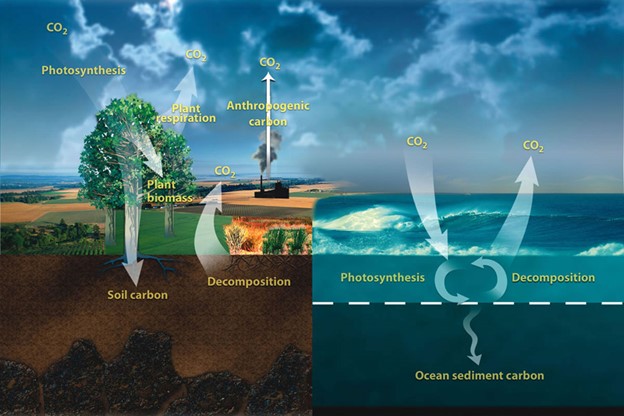How carbon dioxide travels in the atmosphere


Sources of carbon dioxide in the atmosphere
Have you ever wondered how carbon dioxide (CO2) moves through our atmosphere, or how the invisible dance of this particular gas impacts our planet on a global scale? Well, it’s about time we pull back the curtain and shed light on this fascinating phenomenon.
The expert behind the latest captivating observations of our Earth’s atmosphere is climate scientist Lesley Ott from NASA’s Goddard Space Flight Center in Greenbelt, Maryland. The research brings us closer to understanding the complex movements of carbon dioxide.
Sources of carbon dioxide in the atmosphere
Let’s start by understanding the patterns of carbon dioxide movement. If we were to imagine the Earth from afar, between January to March of 2020, the swirling patterns of concentrated carbon dioxide would be noticeable, driven by wind patterns and atmospheric circulation.
China, the United States, and South Asia majorly contribute to CO2 emissions. The primary sources of these emissions are power plants, industrial facilities, and automobiles.
Africa and South America’s emissions are largely due to fires, especially those related to land management, controlled agricultural burns, deforestation, and the burning of oil and coal.
Mapping carbon dioxide movement in atmosphere
The map of carbon dioxide movement was created using a model called GEOS, short for the Goddard Earth Observing System. It’s a high-resolution weather model, powered by supercomputers. The resolution of this model is more than 100 times greater than a typical weather model.
Ott and fellow climate scientists were curious about what GEOS would reveal regarding the movement and density of carbon dioxide.
“We had this opportunity to say: can we tag along and see what really high-resolution CO2 looks like?” Ott said. “We had a feeling we were going to see plume structures and things that we’ve never been able to see when we do these coarser resolution simulations.”
Why the pulsing pattern?
You may be wondering about the pulsation seen in the carbon dioxide distribution patterns. The pulsations are due to the day-night cycles of fires flaring up and dying down and the photosynthetic activities of trees and plants.
Furthermore, the atmospheric layer called the planetary boundary layer also contributes to the pulsation due to its rising and falling motion as the Earth’s surface heats and cools.
Significance of the study
Understanding patterns of carbon dioxide movement is vital to tackle climate change. As a heat-trapping greenhouse gas, carbon dioxide is the main contributor to Earth’s rising temperatures. An excessive amount of carbon dioxide in the atmosphere causes the Earth to warm too quickly.
Human activities have “unequivocally caused warming,” according to the latest report by the Intergovernmental Panel on Climate Change. This warming leads to extreme weather events and other severe consequences such as intense storms, wildfires, heat waves, and rising sea levels.
The art of visualization
The challenge for AJ Christensen, a senior visualization designer at NASA, was to show the differences in density of this invisible gas.
“We didn’t want people to get the impression that there was no carbon dioxide in these sparser regions,” said Christensen. “But we also wanted to really highlight the dense regions because that’s the interesting feature of the data. We were trying to show that there’s a lot of density over New York and Beijing.”
These visualizations are important to understand how Earth’s systems work and to identify patterns in massive datasets, which can lead scientists closer to deciphering the puzzle of Earth’s atmospheric processes.
“What’s happening is you’re stitching together this very complex array of models to make use of the different satellite data, and that’s helping us fill in this broad puzzle of all the processes that control carbon dioxide,” Ott said.
“The hope is that if we understand greenhouse gases really well today, we’ll be able to build models that better predict them over the next decades or even centuries.”
Remember, understanding our planet starts with paying attention to the smallest details, even the invisible pattern of gases in our atmosphere.
Source: earth.com








